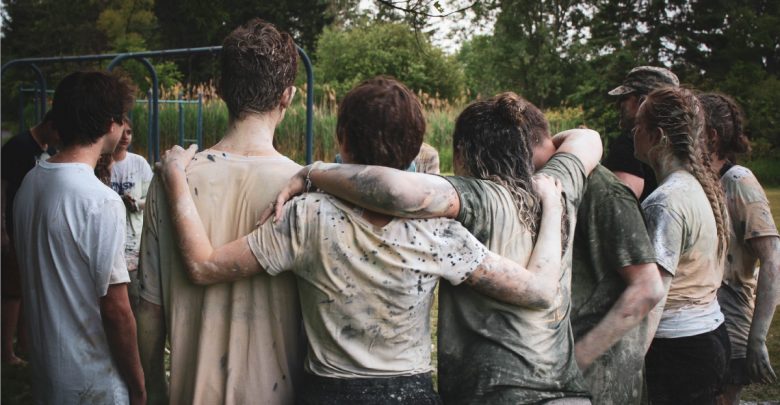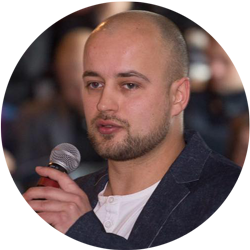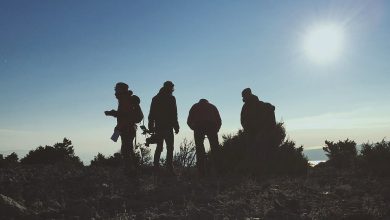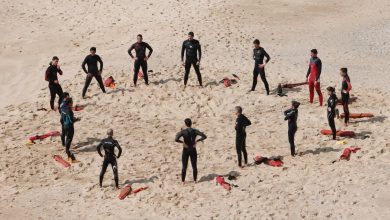The Theory of Group Dynamics
The Knowledge of group processes and the ability to recognize them while working with a group, allows one to choose work methods more effectively and to organize the learning processes more consistently.

Why did I choose this tool?
Knowledge of group processes and ability to recognize and influence group dynamics is one of the most important competencies for a trainer. Delivering effective training programme is closely related to interactions between participants, fortunately, we as trainers, might help participants to build a “learning community”, while learning and living together in the training context.
Main content:
Before we start to talk about groups, we want to make a distinction between the notions of a group and a team. Being active in the context of youth work we realize that these notions are often mixed. They both have certain similarities, but they are not the same.
“A team is a small group of people, who have complementary • characteristics. They are committed and bear common responsibility for a common goal and methods as well as implementation of tasks.” (Katzenbach J. R., Smith D. K., 1992)
“A group can be defined as: interrelated people, who know • about each other and perceive themselves as a group.” (AndrzejHuczynski, David A. Buchanan, 1997)
As you can see from these notions both ‘group’ and ‘team’ are a certain combination of people. Human reciprocity is characteristic to both of them. People in a team put all their effort into achieving a common goal. They discuss in great detail what they are aiming at and how they will reach it, so they use all the team resources for the pursuit of that goal. People in a group are not focused on the achievement of a single common goal. They communicate; they may cooperate, learn from the experience of a common activity and reach agreements together, but often they pursue their own personal goals.
In youth work we may encounter groups: in international youth exchanges; via youth initiatives; in youth centers and open youth centers; in community centers; whilst consulting with non-formal youth groups etc. The goals we are pursuing may be different with different groups.
Orientation towards a group. The attention is directed towards the creation of a favorable microclimate in the group, in an attempt to create conditions for group members to freely share ideas, try to take certain responsibilities, learn from experience, share feelings and give each other feedback, etc.
Orientation towards a team. The attention is directed towards understanding the common team goal, knowing the team resources (knowledge of team resources) and the definition of work procedures. In other words, asking questions like: ‘Who are we?’, ‘What do we pursue and how will we pursue it?’
Frequently, working with a group and certain elements of a team are often intertwined. For instance, in group formation tasks, which have an encoded pursuit of a common goal, we try to provoke the group to openly share their ideas and realize certain norms that apply to that group, but we are not aiming to make a team out of a group, even if the task is quite team-like.
We are not aiming to make a team, since this group will not have to implement a common project. Our goal is to tighten the interrelation between group members in order to make them learn about themselves and from each other.
A group is a living organism. An organism which is born, grows, matures and decays. Many different phenomena take place in a group simultaneously, and they are called group processes. The change of those phenomena, in the whole, is called group dynamics. The processes of each group have certain regularities, but these processes are always unique and special. This specificity is determined by the differences between the people in the group. Each group member enters the group with his own experiences, abilities, knowledge, attitudes and personal qualities, and then anything can happen. Group members reveal themselves sooner or later and start interacting: conflicting, going crazy, having elaborate night talks, being happy, crying. A professional youth worker always has to be ready to be surprised and never perceive anything as constant.
Quite frequently in youth work with groups we are asked to compare groups – “How did the others do?”, “Did we do better than the other groups?”. We try to avoid any comparison deliberately, because it wouldn’t be fair group-wise and attitude-wise for us as trainers. We endeavour to make the group look deeper into their authentic experiences, which take place ‘here and now’, and not try to compete with some other groups.-
Recognizing group processes is one of the most subtle skills of a trainer. A trainer’s ‘nose’ for sensing group processes has to be constantly trained and improved. Strong competence of working with groups ensures a worker’s ability to react ‘here and now’ to group processes and use those processes for educative purposes. This competence can be trained and improved while working with groups and curiously observing what goes on in a group, how people interact, and what influence a trainer’s interventions make.
Interaction among group members or between group members and the trainer, depends on certain regularities, which manifest in a similar way and help the trainer to better understand the group process and act accordingly (make interventions: ask, provoke, support, use a certain method, etc.). Group development stages can sometimes unfold faster, or slower, a stage can be surpassed, or the previous stage can be returned to; some group members may remain in one stage of the group process, while at the same time, others are approaching the next stage.
STAGES OF GROUP DYNAMICS
The forming stage: “Where are we? What is going to happen? Who are these other people?”
What is going on in the group?
Group members are going through a lot of uncertainty and fears of being misunderstood or rejected. Relationships between group members are hesitant: at first members keep a certain distance in order to feel safe and only display their good traits. Frequently, the members of a new group are polite and careful, even if they disagree with someone else’s opinion, they do not voice it and do not argue. However, there are cases when other group members are subtly depreciated or degraded in order to show off. Hesitancy can also manifest via demonstration of silliness or withdrawal. Group members ‘nose around’: explain common expectations, look for common forms and rules (group norms) of being together, yet still do not establish strong relations. Group members look up to the trainers. They generally do not take any responsibility and wait for clear directions and guidance from the trainers.
The role of the trainer
In the orientation (introduction) stage, trainers have to lead explicitly, since they are expected to do so. They have to properly plan the programme and offer a clear structure. The trainer has to encourage the group members to introduce themselves, try to eliminate their worries and offer them a positive experience in a new group. The goal of the trainer is to minimize the existing uncertainty: inform the group on logistic matters (how long the programme will take, when the meal time is, where to live, where the restroom is, etc. – depending on the work context of the group), and also organize introductions in the group – ‘ice breaking’ tasks, name games, introduction tasks. In general, the trainer has to help the group to find answers to the following questions: Where are we? What is going to happen here? Who are these other people? We want to stress that the role of the leader is to help the group to introduce themselves and orient in the setting, and not to give his/her own answers and adjust the group according to his/her own preferences. A group has to grow on its own, with the help of the trainers.
The storming stage: “Where is my place? Whom should I listen to? Why are you bossing me around?”
What is going on in the group?
The group members have introduced themselves with the help of the trainers. Group members feel calmer, they know each other’s names, and can express opinions more freely. The group starts working together. The group members find it easier to express their opinions, which can differ considerably among different members. Group cooperation norms become increasingly relevant, and there is a great need for clarity in members’ interrelations, decision taking and aspects of leadership.
Group members often express their dissatisfaction with the group work, they criticize the behaviour of other members, and the trainer finds him/herself in the middle of a criticism-crossfire. People who can make decisions stand out in the group and they become recognized as non-formal leaders.
Each group member has influence on the development of the group. Doubts appear about what has happened up until now, and what goes on right in this moment, therefore a possibility arises to once more decide on the programme, structure and rules of behaviour in the group. The group has to decide on whether they continue to be together and the matters of common work.
The role of the trainer
It is important that the trainer pays attention to what goes on in the group and helps them realize which norms (certain agreements) apply to this group. In other words, the trainer should help the group to find out and name what helps them to work together.
The goal is for both, the group members and the leader, to agree on generally acceptable group norms: how common decisions will be taken, will there be a chance to express possibilities about a different approach in the decision making process etc. It means that the group discusses both the internal group rules and the role of the trainer.
The main methods to be used in this stage are developmental tasks of group saturation and sense of teamwork.
Norming stage: “Yes, we can do it!”
What is going on in the group?
Group members are glad about every meeting. It is nice to see each other again and it would be a shame to miss something. The feeling of affinity (the ‘WE’ feeling) increases, interrelationships become more intense – talks become more open and communication flows naturally. ‘WE’ are in a good mood and the ideas are sky-high. Frequently, group members start ‘going crazy’ – they do not sleep at night, they lightly (and sometimes not so lightly) joke with the trainers, enjoy each other’s company and think of numerous ways to express it.
The confidence of the group grows. Group members learn to differently evaluate and tolerate each other. In this kind of group atmosphere, needs are expressed openly and different opinions are exchanged. Group members develop different ideas and are able to decide on their interests and protect them. However, ideas often fade away, since people and relationships in the group are now a central focus and the group may fail to carry out its tasks.
The role of the trainer
In this stage of group development, the trainer has several choices.
- Let the group be, by stepping back. Group members enjoy being together, so one of the leader’s choices is non-intervention.
- Join the group and experience the confidence-building processes together.
- Enhance the feeling of confidence in the group by offering various methods, which encourage confidence among group members. Confidence enhances self-awareness and satisfaction. The trainers can offer something that forms and maintains the confidence in the group. At the same time, the boundaries of separate group members have to be accepted and defended unconditionally.
Regardless of the decision you make, it is important to be watchful and supervise the security of the group members. Ideas grow sky-high in the confidence stage and they aren’t always safe. The trainer has to stop the group in time, if she/he sees that ideas are becoming dangerous. In this stage, the members of the group get to know each other intensely.
Life stories, plans and skills of self-discovery are being shared. Relationship clarification via feedback can now be the content of working with the group.
Also, topics that require an atmosphere of confidence in the group (e.g. sexuality, fear, meaning of life, death, belief and spirituality, etc.) might arise. However, the group decides on the topics. It is the time when group members are given increasingly more responsibility for what goes on in the group.
In this confident stage, the group is very reluctant to accept new members. If a new member joins, in order to achieve his/her full integration into the group, the first two stages of group development should be repeated.
Performing stage: “We’ve already made it! Let’s do more!!”
What is going on in the group?
The group’s wish to act is unstoppable. It engages in small and big projects. If difficulties arise, the group looks for solutions jointly. Usually success leads the group, but even a failure doesn’t stop them. The group wants to expand connections: it establishes contact with other groups and sometimes wants to represent their interests politically. Each group member finds his place in the group. Group members acknowledge one another as different personalities, having individual abilities that are all significant. Everyone can make their contribution to the group work. The group communicates fluently, the personal and group interests become equally important, so the group itself is efficient. Group members take responsibility for further group work (self-organization).
The role of the trainer
This is the guiding principle at this stage: what the group members can do by themselves, they should do it by themselves. Now, the trainer takes up the role of a group advisor. The trainer creates a space for a group reflection, gives feedback depending on how she/he sees and feels the progress of the group process. The trainer supports the group in conflict situations, advises the group methodically and ensures that the conditions and the means required for group work are in place (or the group ensures them themselves).
Informing stage “Soon, everything will be over. We will say goodbye”
What is going on in the group?
Time is up. It seems that group members have nothing left to say. It becomes increasingly hard to look for solutions, therefore no results are achieved. The amount of dissatisfaction increases, everybody gets bored, the blame is put on others. Some group members will leave the group soon. Others reminisce about the days that have passed and are now unreachable. But this cannot continue!
We would like to mention several reasons for the disintegration of the group:
Groups break down because it’s the end of being together, which was foreseen from the start (training groups, summer camp groups, groups of international youth exchange, etc.). Groups break down because they start focusing on other matters. In new living conditions, the group cannot remain in the usual space, or the group is no longer given the same meaning and significance. Changes may arise due to professional learning or studies, change of the living place or a search for other forms of pastime and new contacts.
The disintegration of the group is emotionally hard, because separation is related to sadness. At first nobody voices the obvious fact “Our group is disintegrating”. Everybody feels the end approaching and that the last meeting of the group is near. Yet nobody speaks about it, they try not to think about it, because the group members can feel separation is coming. For this reason, conflicts emerge in the group, behaviour patterns, characteristic to the previous group stages re-emerge (regression).
The role of the trainer
The task of the trainer is to create conditions for the constructive process of disintegration. The trainer has to make a subject of the group’s disintegration. At first it may be in the form of feedback to the group. This way the group members and leader come closer to the topic of separation and individual emotional states arise.
The group determines the moment of separation, and sets the time for the last meeting of the group. Also, the following questions have to be discussed: What do we want to do together now? What can remain unchanged? What did we experience and achieve together? How do we want to say goodbye?
It is important to raise those questions in advance, when the exact time for the last meeting is known, so that group members can purposefully decide on the use of the remaining time together.
The separation process finalizes the content of the group, expresses emotions and suggests discussing the relationship once more. It influences the farewell of group members, leaves good memories and creates conditions for new contacts and relationships.
Reflection questions:
Please reflect on your experiences in various groups and presented stages of group dynamics?
Have you experienced the stages which are presented? How it was for you?
How group leaders were influencing the dynamics of the group? What interventions they were implementing?





